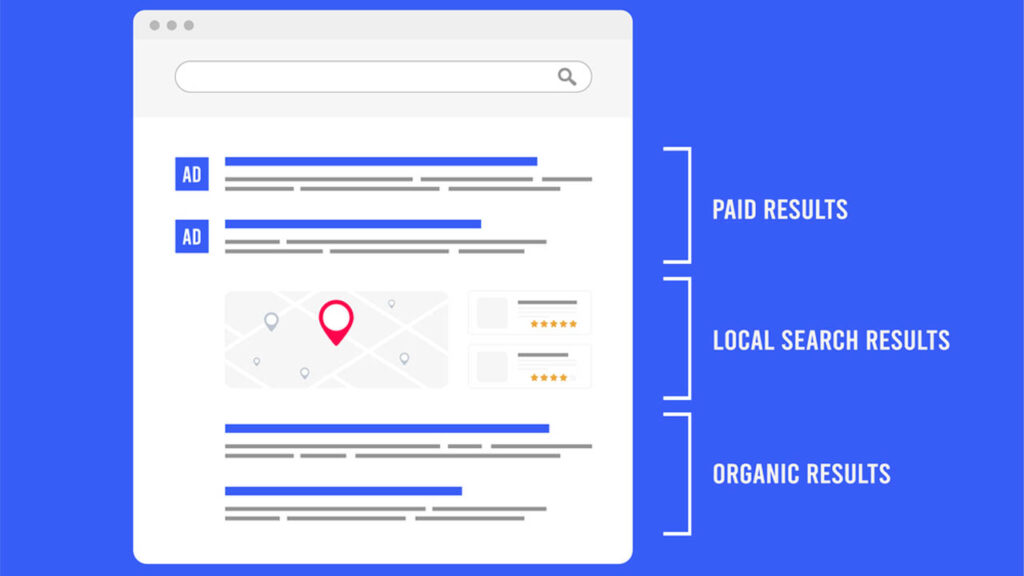Unpacking SERP Meaning: Your Essential Guide to Search Engine Results Pages
Brett Lewis
SEO - June 24, 2024

SERP stands for Search Engine Results Page, the interface displaying a mix of organic listings and paid ads after you enter a query. Understanding SERP meaning is vital for navigating search engines effectively and optimizing online content. This article breaks down the components of SERPs and their impact on search and SEO strategies.
Key Takeaways
- SERPs include a mix of organic search results ranked by relevance and paid search ads determined by an auction system, both tailored to respond to the user’s search queries.
- Search engines use complex algorithms with numerous ranking factors, such as keyword usage, site speed, and mobile-friendliness, to determine the placement of web pages in SERPs.
- SEO and digital marketing play a pivotal role in SERP rankings through on-page optimization, such as keyword-enriched content and user experience improvements, and off-page techniques like content marketing and social media engagement.
Deciphering SERP: A Comprehensive Definition
SERP, or Search Engine Results Page, is a term used to describe the pages displayed by search engines in response to a user’s query. When you input a search term into a search engine, the results are not random. They’re a carefully curated collection of web pages, ads, and other features tailored to your search query, including the Google SERP. These collections of pages are known as search results pages, which are essentially the same as search engine results pages.
These results are bifurcated into two primary categories: organic search results and paid search results. Organic search results are ranked based on their relevance to your query, while paid search results are advertisements related to your search terms.
Anatomy of a Search Engine Results Page

Diving deeper into the anatomy of a SERP, these pages consist of various elements such as organic pages, sponsored ads, and other features designed to provide the most relevant and helpful information to the user’s search query.
Let’s dissect these components further in the following sections.
The Core of Organic Search Results

Organic results are the heart of any SERP. These are websites listed without an ‘ad’ label and ranked based on relevance, authority, and other factors. In essence, these are the results that the search engine believes are the most pertinent to your query.
How does a search engine determine what’s relevant? This is where search engine algorithms come into play. These complex systems rank organic results based on how well they address the algorithm’s criteria through SEO. Hence, high-quality, compelling, and unique content is a key factor in SEO success.
The Dynamics of Paid Search Ads

In contrast to organic results, paid search ads are those that appear above or below organic results, marked with an ‘ad’ label. On average, you’ll find three to four ads per page, presented in various formats.
The visibility of these ads on SERP is determined by an auction system where factors such as bid amount, quality of the landing page, and ad relevance to the search are considered. Known as the Pay-Per-Click (PPC) model, advertisers pay the search engine each time their ad is clicked, emphasizing the importance of budget allocation in search engine marketing.
These paid search results, also known as Google search results, are referred to as sponsored links or Google ads, and are often provided by search engine providers.
Spotlight on Featured Snippets
Featured snippets are another vital component of SERPs. These are large highlights from webpages summarizing important information related to search keywords and displayed in a card format, often paired with an image and the URL.
Featured snippets are positioned at the very top of the organic search results, known as ‘position #0’. They provide quick, direct answers to user queries and can appear in the form of text or video at the top of SERPs.
Behind the Scenes: How Search Engines Populate SERPs
Now that we’ve unraveled the structure of a SERP let’s take a backstage tour to understand how search engines populate these pages. Understanding this process will help us appreciate the complexity of SERPs and the intelligence of search engine algorithms.
Understanding Search Algorithms
Search engine’s algorithm is the secret sauce behind the search results you see. These algorithms are continuously evolving to improve the relevance and usefulness of search results, taking into account users search behavior and preferences. As these algorithms change, strong SEO practices must adapt accordingly to align with the updates and changes.
To grasp the complexity of these algorithms, consider this: Google’s algorithm employs over 200 ranking signals to determine the placement of organic search results. These signals include factors like keyword usage, site speed, and mobile-friendliness, to name a few.
Ranking Factors Decoded
Ranking factors are the criteria that search engines use to evaluate and rank web pages. Among these factors, high-quality backlinks from reputable and relevant websites signal to search engines the value of a website’s content. Building high-quality backlinks can significantly improve a site’s authority and search ranking.
Another crucial ranking factor is the mobile-friendliness of a website. Given that most internet browsing occurs on mobile devices, ensuring that your website is mobile-friendly is a non-negotiable requirement for good SEO and higher SERP rankings.
The Role of SEO in Crafting Search Engine Results
With a better understanding of SERPs and the factors that influence them, let’s delve into the role of Search Engine Optimization (SEO) in crafting these results. SEO involves a multitude of techniques and strategies aimed at making a website more attractive to search engines.
On-Page SEO Tactics
On-page SEO refers to practices that make content easily discoverable for both users and search engine bots. This involves optimizing various elements of your webpage, such as the title tags, meta descriptions, and headers, for target keywords.
In addition to keyword optimization, user experience factors also play a significant role in on-page SEO. These include:
- Easy navigation
- Fast-loading pages
- Mobile responsiveness
- Descriptive URLs
Even the URL structure of your web pages can impact your site’s SEO, helping users and search engines understand the content and structure of your website.
Off-Page SEO Strategies
While on-page SEO focuses on optimizing the content and elements within your website, off-page SEO looks beyond the confines of your site. Off-page SEO encompasses strategies that enhance a site’s authority and ranking beyond the website itself.
Common off-page SEO activities include content marketing, making submissions to directories and search engine indexes, and more. Additionally, engagement on social media platforms is a crucial off-page SEO practice. Though it may not directly improve SERP results, it can increase your content’s visibility and drive more web traffic, indirectly influencing your SERP rankings.
Navigating Through SERP Features

Having explored the basics of SERPs and the role of SEO in shaping them, let’s now turn our focus to the various features that enhance the SERP experience. These features not only enrich the user’s search but provide additional opportunities for businesses to rank within these sections.
Knowledge Panels and Graphs
Knowledge Panels and Graphs are enhanced search results providing concise answers and key facts about search queries directly within the SERP. They are part of Google’s endeavor to make information more accessible and user-friendly.
These panels and graphs contain specific details such as a person or company’s ‘baseball card’ stats, sourced from trusted references like Wikipedia and Crunchbase. By providing immediate responses to specific questions and offering additional related information, these features significantly enhance the user’s search experience.
Local Pack and Its Significance
Local Packs are another essential feature of SERPs. The information displayed includes details of nearby businesses and organizations, along with an embedded map from Google Maps. This feature provides users with convenient access to local resources. The local pack is generated when a search query includes a location name, or when Google’s algorithm identifies nearby available items. This feature provides users with convenient access to local information..
For businesses, appearing in Local Packs can significantly enhance visibility. Ensuring their Google My Business profile is complete, accurate, and regularly updated, in addition to gaining customer reviews, can help businesses optimize their Local Pack presence.
Enhancing Visibility with Shopping Results

Shopping results are a boon for e-commerce businesses. These results display products directly within the SERP, connecting customers with retailers and increasing conversions. To enhance visibility in Google Shopping, retailers are advised to provide detailed product information, high-quality images, and accurate product titles enriched with essential keywords.
In addition to these, using Global Trade Item Numbers (GTINs) for product listings and optimizing product feeds without keyword stuffing can significantly improve search results. Testing changes in the Google Shopping feed and analyzing the results through analytics can help refine the strategy to reach more consumers.
Maximizing Visibility: Tips for Climbing to the Top of the SERP
Maximizing visibility on SERPs is a critical objective for every business with an online presence. To achieve this goal, businesses should focus on updating content with current search terms and aligning it with user intent. This approach can significantly improve SERP rankings.
Additionally, here are some strategies to improve your SERP ranking:
- Enhance page titles with target keywords to make the pages more pertinent to specific queries
- Focus on well-structured content and appropriate internal linking strategies to reduce bounce rates and improve SERP positioning
- Secure more backlinks from credible sources to boost rankings and indicate content authority.
Summary
In summary, SERPs are a complex blend of organic and paid search results, complemented by a variety of features designed to enhance the user’s search experience. Understanding the mechanics behind SERPs and the role of SEO in shaping these results is crucial for businesses aiming to boost their online visibility. With the right strategies and a keen understanding of search algorithms, businesses can effectively climb to the top of the SERP and reach their target audience to generate leads more effectively.
Frequently Asked Questions
What is a SERP?
A SERP is a Search Engine Results Page. It is the page shown by a search engine after a user enters a query, containing a combination of organic and paid results customized to the query.
What is the difference between organic and paid search results?
The main difference between organic and paid search results is that organic results are ranked based on relevance to the user’s query, while paid results are advertisements related to the search terms.
What are search algorithms?
Search algorithms are complex systems used by search engines to determine the relevance of web pages to a user’s search query, using over 200 ranking signals to place organic search results.
What is on-page and off-page SEO?
On-page SEO involves optimizing content for user and search engine discoverability, while off-page SEO focuses on external signals like backlinks and social signals to improve ranking. Both types are important for a comprehensive SEO strategy.
How can I improve my visibility on Google Shopping?
To improve your visibility on Google Shopping, ensure you provide detailed product information, high-quality images, and accurate product titles enriched with essential keywords. Using GTINs for product listings and optimizing product feeds without keyword stuffing can also help enhance visibility.
